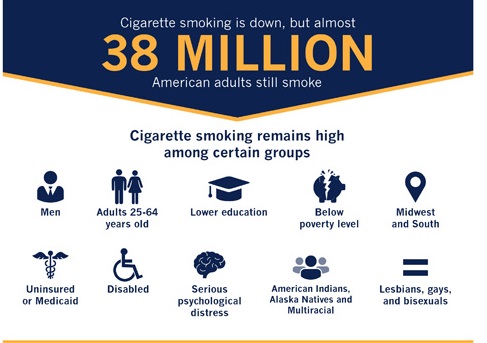Washington, D.C.–Overall, cigarette smoking among U.S. adults (aged ≥18 years) declined from 20.9 percent in 2005 to 15.5 percent in 2016. Yet, nearly 38 million American adults smoked cigarettes (“every day” or “some days”) in 2016, according to data released January 18 by the Centers for Disease Control and Prevention (CDC).
Cigarette smoking among U.S. adults has been reduced by more than half since 1964, yet remains the leading preventable cause of disease and death in the United States. It kills more than 480,000 Americans each year.

The new data, from the National Health Interview Survey (NHIS), show that among adults who have ever used cigarettes, the percentage who have quit increased from 50.8 percent in 2005 to 59.0 percent in 2016. During 2005–2016, the largest increase in quitting was among adults ages 25–44 years.
Since 1965, the NHIS has tracked cigarette smoking, the most common form of tobacco product use among U.S. adults. The U.S. Surgeon General has concluded that the burden of death and disease from tobacco use in the United States is overwhelmingly caused by cigarettes and other combusted tobacco products.
Among daily smokers, the average number of cigarettes smoked per day declined from about 17 cigarettes in 2005 to 14 cigarettes in 2016. The proportion of daily smokers who smoked 20 to 29 cigarettes per day dropped from 34.9 percent in 2005 to 28.4 percent in 2016, while the proportion who smoked fewer than 10 cigarettes per day rose from 16.4 percent in 2005 to 25 percent in 2016.
Despite this progress, disparities in smoking persist across population groups. Cigarette smoking was especially high among males, those aged 25-64 years, people who had less education, American Indians/Alaska Natives, Americans of multiple races, those who had serious psychological distress, those who were uninsured or insured through Medicaid, those living below the poverty level, those who had a disability, those who were lesbian, gay, or bisexual, and those who lived in the Midwest or South.



















